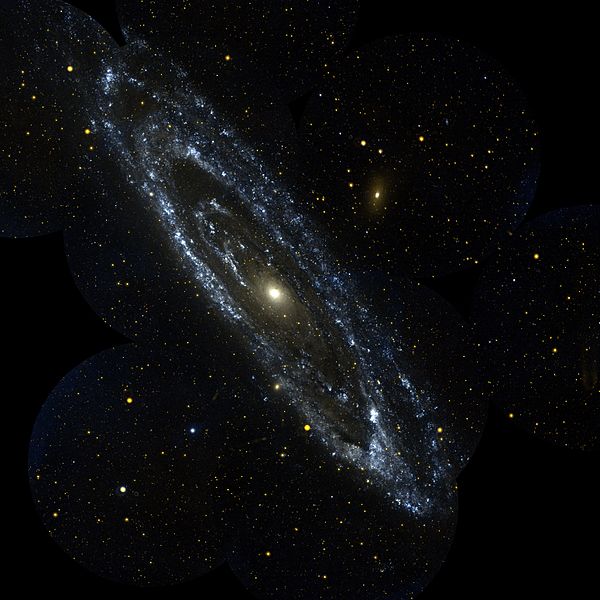Image: Andromeda galaxy

Description: This image is in ultraviolet waves! This image is a Galaxy Evolution Explorer observation of the large galaxy in Andromeda, Messier 31. The Andromeda galaxy is the second massive in the local group of galaxies that includes our Milky Way. Andromeda is the nearest large galaxy to our own. The image is a mosaic of 10 separate Galaxy Evolution Explorer images taken in September, 2003. The color image (with near ultraviolet shown by red and far ultraviolet shown by blue) shows blue regions of young, hot, high mass stars tracing out the spiral arms where star formation is occurring, and the central orange-white "bulge" of old, cooler stars formed long ago. The star forming arms of Messier 31 are unusual in being quite circular rather than the usual spiral shape. Several companion galaxies can also be seen. These include Messier 32, a dwarf elliptical galaxy directly below the central bulge and just outside the spiral arms, and Messier 110 (M110), which is above and to the right of the center. M110 has an unusual far ultraviolet bright core in an otherwise "red", old star halo. Many other regions of star formation can be seen far outside the main body of the galaxy.
Title: Andromeda galaxy
Credit: This image or video was catalogued by Jet Propulsion Laboratory of the United States National Aeronautics and Space Administration (NASA) under Photo ID: PIA04921. This tag does not indicate the copyright status of the attached work. A normal copyright tag is still required. See Commons:Licensing for more information. Català | Čeština | Deutsch | English | Español | فارسی | Français | Galego | Magyar | Հայերեն | Bahasa Indonesia | Italiano | 日本語 | Македонски | മലയാളം | Polski | Português | Русский | Türkçe | 中文 | 中文(简体) | +/−
Author: NASA/JPL/California Institute of Technology
Permission: This file is in the public domain in the United States because it was solely created by NASA. NASA copyright policy states that "NASA material is not protected by copyright unless noted". (See Template:PD-USGov, NASA copyright policy page or JPL Image Use Policy.) Warnings: Use of NASA logos, insignia and emblems is restricted per U.S. law 14 CFR 1221. The NASA website hosts a large number of images from the Soviet/Russian space agency, and other non-American space agencies. These are not necessarily in the public domain. Materials based on Hubble Space Telescope data may be copyrighted if they are not explicitly produced by the STScI.[1] See also Template:PD-Hubble and Template:Cc-Hubble. The SOHO (ESA & NASA) joint project implies that all materials created by its probe are copyrighted and require permission for commercial non-educational use. [2] Images featured on the Astronomy Picture of the Day (APOD) web site may be copyrighted. [3] The National Space Science Data Center (NSSDC) site has been known to host copyrighted content even though its photo gallery FAQ states that all of the images in the photo gallery are in the public domain.
Usage Terms: Public domain
License: Public domain
Attribution Required?: No
Image usage
The following 2 pages link to this image:

